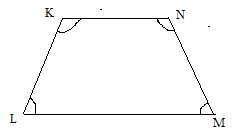
Draw a rough sketch of a quadrilateral . State two pairs of opposite angles.
Answer
568.5k+ views
Hint: In this question, first we will draw the rough sketch of a quadrilateral. Then we will define the term quadrilateral and its properties. After this, we will define the adjacent and opposite angles in quadrilateral.
Complete step-by-step answer:
Let’s draw a rough sketch of a quadrilateral.

So, this is the diagram of a general quadrilateral.
Now, we will define quadrilateral:
A polygon bounded by four sides is called a quadrilateral.
Properties of quadrilateral are as follow:
1. It has four sides.
2. It has four vertices.
3. The sum of all internal angles is 360 degree.
The different types of quadrilateral are:
1. Square:- All sides are equal and opposites sides are parallel. Each angle is 90 degrees.
2. Rectangle- opposite sides are equal and parallel. Each angle is 90 degrees.
3. Rhombus- All sides are equal and opposites sides are parallel.
4. Trapezium- -One pair of opposite sides is parallel and the other pair is not parallel.
Now, let’s see the definition of adjacent and opposite angles.
1. Adjacent angles- The angles formed on the sides of the quadrilateral are called adjacent angles.
\[\angle KLM\] and \[\angle LMN\]are adjacent angles.
2. Opposite angles- The angles formed on the opposite vertices of the quadrilateral are called opposite angles.
So, \[\angle KLM\]and \[\angle MNK\], \[\angle MKL\]and \[\angle LMN\] are the two pairs of opposite angles of a given quadrilateral.
Note: In such a type of question, you should have knowledge of basic things like definition of different types of polygon, adjacent angles, vertices, opposite angles etc. The formula for calculating the sum of internal angles of a polygon is (n – 2)$ \times {180^0}$, where ‘n’ is the total number of sides.
Complete step-by-step answer:
Let’s draw a rough sketch of a quadrilateral.

So, this is the diagram of a general quadrilateral.
Now, we will define quadrilateral:
A polygon bounded by four sides is called a quadrilateral.
Properties of quadrilateral are as follow:
1. It has four sides.
2. It has four vertices.
3. The sum of all internal angles is 360 degree.
The different types of quadrilateral are:
1. Square:- All sides are equal and opposites sides are parallel. Each angle is 90 degrees.
2. Rectangle- opposite sides are equal and parallel. Each angle is 90 degrees.
3. Rhombus- All sides are equal and opposites sides are parallel.
4. Trapezium- -One pair of opposite sides is parallel and the other pair is not parallel.
Now, let’s see the definition of adjacent and opposite angles.
1. Adjacent angles- The angles formed on the sides of the quadrilateral are called adjacent angles.
\[\angle KLM\] and \[\angle LMN\]are adjacent angles.
2. Opposite angles- The angles formed on the opposite vertices of the quadrilateral are called opposite angles.
So, \[\angle KLM\]and \[\angle MNK\], \[\angle MKL\]and \[\angle LMN\] are the two pairs of opposite angles of a given quadrilateral.
Note: In such a type of question, you should have knowledge of basic things like definition of different types of polygon, adjacent angles, vertices, opposite angles etc. The formula for calculating the sum of internal angles of a polygon is (n – 2)$ \times {180^0}$, where ‘n’ is the total number of sides.
Recently Updated Pages
Master Class 9 Social Science: Engaging Questions & Answers for Success

Master Class 9 Science: Engaging Questions & Answers for Success

Master Class 9 English: Engaging Questions & Answers for Success

Master Class 9 Maths: Engaging Questions & Answers for Success

Master Class 9 General Knowledge: Engaging Questions & Answers for Success

Class 9 Question and Answer - Your Ultimate Solutions Guide

Trending doubts
Which places in India experience sunrise first and class 9 social science CBSE

Fill the blanks with the suitable prepositions 1 The class 9 english CBSE

Write the 6 fundamental rights of India and explain in detail

Difference Between Plant Cell and Animal Cell

What is pollution? How many types of pollution? Define it

What is the Full Form of ISI and RAW




